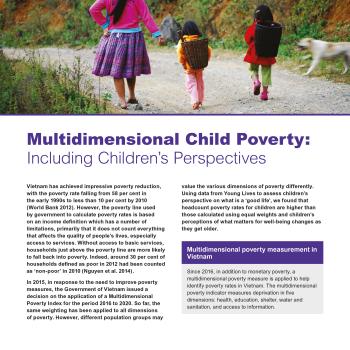Publication Information

Vietnam has achieved impressive poverty reduction, with the poverty rate falling from 58 per cent in the early 1990s to less than 10 per cent by 2010 (World Bank 2012). However, the poverty line used by government to calculate poverty rates is based on an income definition which has a number of limitations, primarily that it does not count everything that affects the quality of people’s lives, especially access to services. Without access to basic services, households just above the poverty line are more likely to fall back into poverty. Indeed, around 30 per cent of households defined as poor in 2012 had been counted as ‘non-poor’ in 2010 (Nguyen et al. 2014).
In 2015, in response to the need to improve poverty measures, the Government of Vietnam issued a decision on the application of a Multidimensional Poverty Index for the period 2016 to 2020. So far, the same weighting has been applied to all dimensions of poverty. However, different population groups may value the various dimensions of poverty differently.
Using data from Young Lives to assess children’s perspective on what is a ‘good life’, we found that headcount poverty rates for children are higher than those calculated using equal weights and children’s perceptions of what matters for well-being changes as they get older.

Vietnam has achieved impressive poverty reduction, with the poverty rate falling from 58 per cent in the early 1990s to less than 10 per cent by 2010 (World Bank 2012). However, the poverty line used by government to calculate poverty rates is based on an income definition which has a number of limitations, primarily that it does not count everything that affects the quality of people’s lives, especially access to services. Without access to basic services, households just above the poverty line are more likely to fall back into poverty. Indeed, around 30 per cent of households defined as poor in 2012 had been counted as ‘non-poor’ in 2010 (Nguyen et al. 2014).
In 2015, in response to the need to improve poverty measures, the Government of Vietnam issued a decision on the application of a Multidimensional Poverty Index for the period 2016 to 2020. So far, the same weighting has been applied to all dimensions of poverty. However, different population groups may value the various dimensions of poverty differently.
Using data from Young Lives to assess children’s perspective on what is a ‘good life’, we found that headcount poverty rates for children are higher than those calculated using equal weights and children’s perceptions of what matters for well-being changes as they get older.

